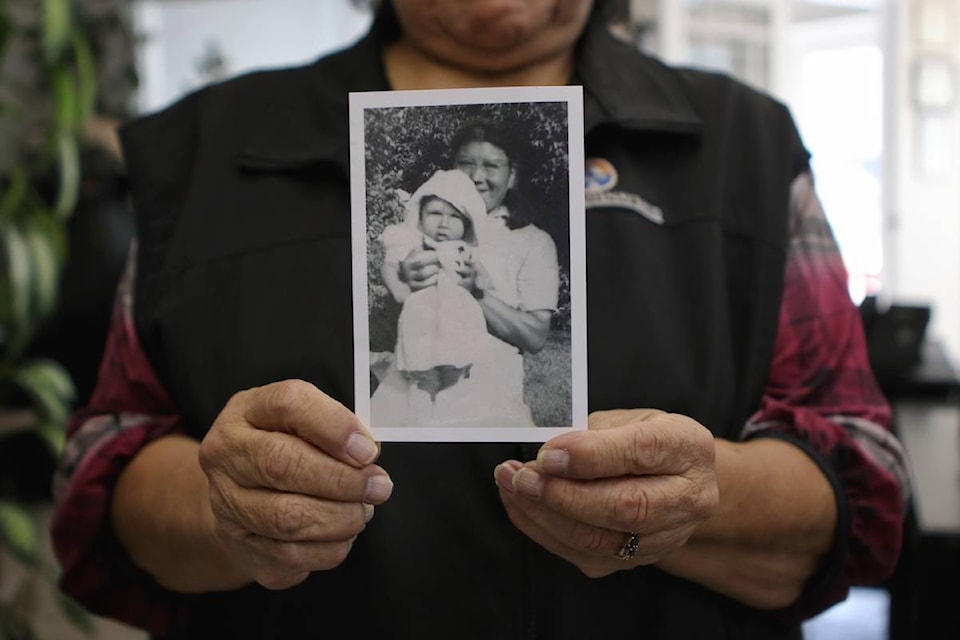This article is Part One of a series that chronicles the life of Lower Kootenay Band Elder Anne Jimmie. The purpose of this series is to preserve the lived experiences of a residential school survivor and to create more awareness in the community around this dark chapter in Canada’s history.
Anne Jimmie was only five years old when she first walked through the doors of Cranbrook’s St. Eugene Indian Residential School.
It was 67 years ago, but Jimmie remembers her first day of school like it was yesterday.
“My mom and dad brought me inside. I remember going in and the first people I met were a priest and a nun. The way they were dressed was what scared me,” said Jimmie. “They started talking — they were speaking in english and I didn’t know english. I spoke Ktunaxa.”
The next thing she remembers is the nun taking her by the hand and leading her down the hall to the upstairs junior dormitory, which housed other little Indigenous girls in grades one through four.
Confused by what was going on, she wanted to turn around and run to her parents. But when she looked back, they were nowhere in sight.
“I started crying. I wanted to go but the nun was holding my hand. I was pulling away but my parents were gone, just like that,” she said. “I was crying and the nun’s voice changed. Even though I didn’t know what she was saying, the voice is what scared me.”
When they got upstairs, Jimmie remembers her of her first day of school outfit that her mom had bought her being stripped away by the nun, who instead gave her a uniform that was to be worn at all times.
She described the first few months of adjusting to this new world as hard. Most of all, she said they were lonely.
“I cried every night. I was in the dormitory with other junior girls, and I would hear the crying during the nights from other girls,” she said. “The nun would come in and threaten us or strap us if we didn’t stop crying. It was hard. The abuses were constant. That became my life for the next eight years.”
During those eight years, Jimmie said she suffered physical, emotional and sexual abuse at the hands of priests, nuns and other students.
“Everyday, I just never knew what was going to come. I always knew I was going to get punished. I was living in fear and being punished,” she said.
The days would begin at 6 a.m., where a nun would come in and clap her hands to wake up the students.
“First thing you had to do was get on your knees and pray. Then you got dressed and went into what they called the lavatory, washed up, brushed your teeth and then you went to mass,” she said.
Mass was followed by breakfast in the dining room, where Jimmie said that students were fed salty, lumpy porridge and sour milk.
“I always thought bread pudding was a slice of bread soaked in sour milk and you had to eat it. We had bread soaked in molasses for snacks,” she said. “Every morning, we had to line up for cod liver oil that was sprayed into our mouths. It was supposed to be some sort of vitamin. That was brutal.”
Students were required to complete chores around the building once breakfast was over, and Jimmie recalled one instance where — as punishment — she was forced to scrub a long flight of stairs with a toothbrush at six years old.
“I remember I was working in the kitchen, and I got punished for not putting the dishes in the right place. I kept getting punished, so I made sure that I put them in the right place, cause I didn’t like the strap, it hurt,” she said. “I came to realize that the nun would deliberately put it somewhere else just to give me the strap.”
Classes started when chores were finished, with the primary subjects being english, math and catechism.
“I learned english pretty quick. I learned that every time I spoke my language I got punished. They would strap me on my hands or on my butt,” she said.
She remembers how staff would also constantly demonize her parents.
“They didn’t use the word alcoholics, but they would call them drunks and say that they didn’t care. It was telling me I was better off in the school and I was there to be civilized, I guess,” she said. “Take the indian out of me - take the Ktunaxa out of me. That was the intent.”
Jimmie was 13 when she finished grade eight in 1961, her final year of studies before attending David Thompson High School in Invermere later that fall.
She had already had her first sip of alcohol when she was only 12. By the age of 14, she said she would drink to get drunk.
“By the time I left the residential school, I didn’t like myself,” she said. “To me, it was like I was one of God’s worst creations. That’s how I felt when I left. The reason is because of all the punishments I got.”
Part Two of ‘Saving the Inner Child’ will explore Jimmie’s life after leaving the residential school system. In particular, the focus will be on her struggles with alcohol abuse, her attempts at navigating the public high school system and her path to overcoming her traumas.
Do you have something to add to this story, or something else we should report on? Email: aaron.hemens@crestonvalleyadvance.ca
@aaron_hemens
aaron.hemens@crestonvalleyadvance.ca
Like us on Facebook and follow us on Twitter.
